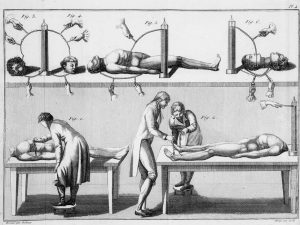Iwan Morus in Independent:
 On 17 January 1803, a young man named George Forster was hanged for murder at Newgate prison in London. After his execution, as often happened, his body was carried ceremoniously across the city to the Royal College of Surgeons, where it would be publicly dissected. What actually happened was rather more shocking than simple dissection though. Forster was going to be electrified. The experiments were to be carried out by the Italian natural philosopher Giovanni Aldini, the nephew of Luigi Galvani, who discovered “animal electricity” in 1780, and for whom the field of galvanism is named. With Forster on the slab before him, Aldini and his assistants started to experiment. The Timesnewspaper reported: “On the first application of the process to the face, the jaw of the deceased criminal began to quiver, the adjoining muscles were horribly contorted, and one eye was actually opened. In the subsequent part of the process, the right hand was raised and clenched, and the legs and thighs were set in motion.”
On 17 January 1803, a young man named George Forster was hanged for murder at Newgate prison in London. After his execution, as often happened, his body was carried ceremoniously across the city to the Royal College of Surgeons, where it would be publicly dissected. What actually happened was rather more shocking than simple dissection though. Forster was going to be electrified. The experiments were to be carried out by the Italian natural philosopher Giovanni Aldini, the nephew of Luigi Galvani, who discovered “animal electricity” in 1780, and for whom the field of galvanism is named. With Forster on the slab before him, Aldini and his assistants started to experiment. The Timesnewspaper reported: “On the first application of the process to the face, the jaw of the deceased criminal began to quiver, the adjoining muscles were horribly contorted, and one eye was actually opened. In the subsequent part of the process, the right hand was raised and clenched, and the legs and thighs were set in motion.”
It looked to some spectators “as if the wretched man was on the eve of being restored to life”.
…The idea that electricity really was the stuff of life and that it might be used to bring back the dead was certainly a familiar one in the kinds of circles in which the young Mary Wollstonecraft Shelley – the author of Frankenstein – moved. The English poet, and family friend, Samuel Taylor Coleridge was fascinated by the connections between electricity and life. Writing to his friend the chemist Humphry Davy after hearing that he was giving lectures at the Royal Institution in London, he told him how his “motive muscles tingled and contracted at the news, as if you had bared them and were zincifying the life-mocking fibres”. Percy Bysshe Shelley himself – who would become Wollstonecraft’s husband in 1816 – was another enthusiast for galvanic experimentation.
More here.
